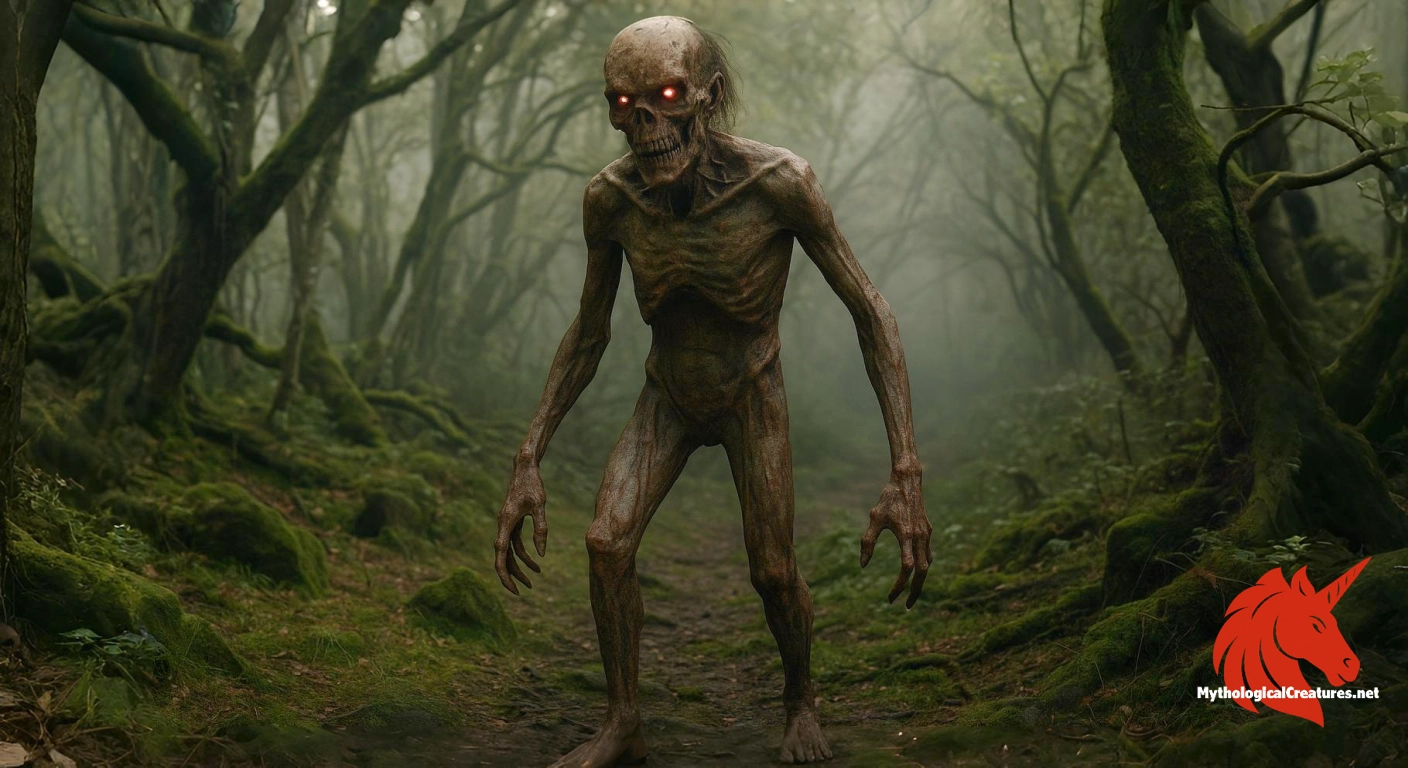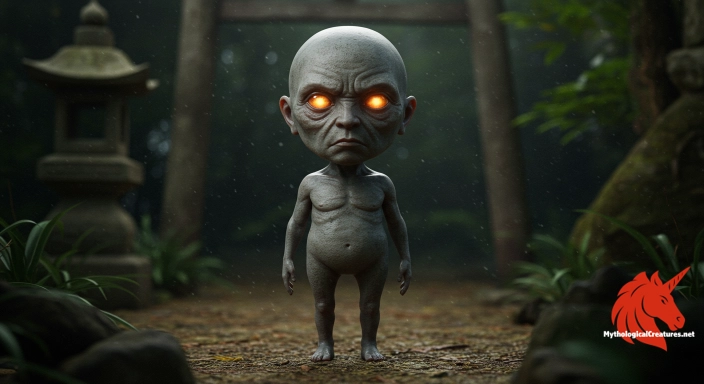Bloody Bones: Bloody Bones is a legendary bogeyman figure from English and North American folklore.

Bloody Bones
Bloody Bones - Serves as a moral parable and warning device, reinforcing proper behaviour through the threat of its fearsome presence.
Origins & First Encounters
Bloody Bones, a formidable figure in both English and North American folklore, made his first documented appearance around 1548 and quickly became an enduring instrument of parental discipline. His many names—Rawhead, Tommy Rawhead, or Rawhead-and-Bloody-Bones—reflect the layered and adaptable nature of his myth across generations. His eerie presence was designed to serve as a stark warning to children, ensuring that disobedience and misbehaviour would not go unpunished. Originating during a time when oral traditions and printed texts intermingled to enforce moral lessons, he embodied the fears of communities living close to unpredictable and dangerous natural landscapes. The character’s grisly demeanour and association with blood and bones symbolised not only physical decay but also the inevitable consequences of straying from accepted social norms. Over the centuries, storytellers imbued him with nuances that mirrored evolving societal concerns about discipline and morality. His early attestations in the mid-sixteenth century mark him as part of a broader tradition of mythic entities used to regulate behaviour. The legacy of Bloody Bones has since traversed time, adapting continuously to the cultural climates of both rural and urban settings. His presence in folklore underscores the powerful role of myth in communicating societal values. Ultimately, his story remains a chilling reminder of the interplay between fear, control, and cultural identity.
Source Texts & Tale Variants
The earliest recorded mention of Bloody Bones dates back to the mid-sixteenth century, a period when emerging printed texts began to codify local legends and moral tales. Although the original documentation provides only a skeletal outline of his character, oral traditions have enriched his narrative with vivid and varied details over time. Folklorists have noted that early manuscripts and local ballads incorporated elements of the terror he inspired, ensuring that his legacy would be passed down through generations. In many traditional accounts, his appearance and actions were described with both allegorical and literal elements, serving as a dual mechanism of warning and entertainment. Different storytellers across regions have contributed to a tapestry of variants, some describing him as a dismembered spirit and others as a malevolent force stalking the night. Variations in his name, such as Rawhead or Tommy Rawhead, highlight the fluidity with which his legend was transmitted and adapted among different communities. The multiple retellings also suggest that his origins may intertwine with older, pre-Christian mythic motifs, even if direct documentary evidence is limited. Local folklore collections from rural English communities and early North American settlements reveal subtle differences in the way his myth is portrayed. These diverse sources collectively illustrate how a single character can evolve through the interplay of recorded texts and dynamic oral traditions. Thus, the story of Bloody Bones reflects a broader narrative tradition where multiple versions coexist and reinforce his role as an agent of caution.
Form & Powers
Descriptions of Bloody Bones are as varied as they are vivid, often portraying him as a spectral entity whose very anatomy evokes terror. He is typically envisioned with a gaunt, almost emaciated body where bones, raw and exposed, seem to glisten with a mysterious, sanguine hue. His head, frequently noted in accounts as being particularly gruesome, is often depicted with a raw, unhealed wound or a visage of exposed, jagged bone. Some portrayals describe him as having elongated limbs and a hunched posture that further contribute to his menacing silhouette. His eyes, when mentioned, are said to burn with an eerie light, evoking both the supernatural and the macabre. Local legends sometimes describe a constant sound of clattering bones accompanying his movements, reinforcing the notion of a body in perpetual decay. Artists of various folk traditions have taken creative liberties, sometimes rendering him as diminutive and spectral, while in other accounts his size is exaggerated to monstrous proportions. The frequent references to dripping blood and splintered skeletal features underline his status as a harbinger of gruesome retribution. Even subtle details, such as the texture of his ragged hair or the unevenness of his step, add layers of horror to his appearance. Ultimately, his mutable physical characteristics serve to symbolise the raw and untamed power of fear embedded in his lore.
Regional Faces
In England, Bloody Bones is primarily woven into the fabric of local folklore as a dreaded bogeyman whose purpose was to scare children into well-behaved conduct. Rural communities often portrayed him as emerging from the dark recesses of ancient woodlands or misty moorlands, where light rarely penetrated. Across the Atlantic, in North American retellings, his character absorbed additional elements from indigenous ghost stories and frontier legends, creating a hybrid figure that resonated with the isolated experiences of early settlers. In these regions, adaptations of his myth sometimes emphasise a more spectral, otherworldly quality, blending the supernatural with the eerie vastness of the wilderness. Some North American variants depict him not only as a moral adjudicator but also as a spirit of the land, charged with punishing those who disturb the sanctity of nature. Local dialects and cultural influences have led to subtle differences in his name and attributes, highlighting the diverse ways in which communities have reinterpreted his story. Urban legends occasionally repurpose his image to address modern societal concerns, yet the core message remains rooted in age-old warnings against misbehaviour. Despite these differences, a shared sense of dread, utilising imposing visual imagery and moral overtones, unites his various incarnations. Within each locale, the myth of Bloody Bones adapts to the unique cultural and environmental backdrop, reflecting community-specific fears and values. This regional malleability underscores the adaptive nature of folklore as it travels across both time and geography.
Cultural Parallels
Across various cultures, the figure of a bogeyman serves to encapsulate communal fears, and Bloody Bones is no exception, finding parallels in legends around the world. The Southern European concept of El Coco, for instance, shares a similar role in instilling discipline among children, utilising frightening imagery to enforce societal norms. In Eastern European traditions, phantom-like entities and demonic figures echo the moralistic undercurrents found in the tale of Bloody Bones. The mechanisms of fear and caution inherent in these stories highlight a universal reliance on myth to manage youthful disobedience and communal uncertainties. While many such figures are shrouded in the mists of local legend, Bloody Bones stands out with his distinct emphasis on raw, bloody skeletal imagery that conveys both decay and retribution. His portrayal resonates with other folk icons like Krampus, who similarly employ grotesque physical features to evoke dread. Though the narratives differ in detail—ranging from spectral beings to overtly monstrous creatures—the fundamental objective of these myths remains to enforce moral behaviour through the power of fear. Comparative analysis reveals that while global bogeyman traditions vary widely, the visceral impact of Bloody Bones lies in his uniquely horrifying embodiment of corporeal decay. His narrative, much like others in different cultures, transforms abstract societal fears into a tangible and nightmarish figure. In this way, Bloody Bones contributes to a shared mythological language that transcends geographical and cultural boundaries.
Legacy & Modern Evolution
From his early mentions in the sixteenth century to his modern reinterpretations, Bloody Bones has undergone a remarkable evolution that mirrors shifts in societal attitudes towards fear and discipline. Once a straightforward bogeyman intended solely to terrify wayward children, his image has gradually assimilated additional layers of symbolism and complexity. Over time, storytellers and artists have reimagined him as both a monstrous enforcer of ancient moral codes and a tragic relic of a bygone era. His brutal, sanguine appearance has been adapted to suit the aesthetics of contemporary horror, finding new life in graphic novels, films, and urban legends. Modern portrayals often straddle the line between menacing villain and antihero, challenging audiences to reconsider traditional interpretations of terror. The metamorphosis of his character reflects broader cultural trends, where folklore is re-examined in the light of modern sensibilities and artistic innovation. While his origins as a cautionary tale remain intact, his legacy now also encompasses the exploration of themes such as mortality, decay, and the persistence of myth. Academic discussions and popular media have both contributed to this layered understanding, ensuring that the story of Bloody Bones remains both adaptive and enduring. His continued presence in festivals, literature, and visual art signals not only a nostalgic remembrance of ancient fears but also a dynamic recontextualisation for modern times. Today, Bloody Bones stands as a potent symbol of how myths evolve, serving as both a mirror to past customs and a canvas for contemporary reinterpretation.
Interesting Fact
An intriguing aspect of Bloody Bones is its adaptability across cultures, reflecting a shared human fear that transcends geographical boundaries.
Quick Creature Info
Features:
Our Mythic Legendary Rating:

Also Sometimes Known As:
Habitat:
Supernatural Powers:
Physical Attributes:
Abilities:
Behavior:
Weaknesses:
Lore:
Related Creatures, Tales or Lore
References
Discover Another Mythical Legend You May Not Have Heard Of?
Uncover the mysteries of ancient folklore and expand your knowledge of legendary beings from cultures around the world.
Dare to Meet the Makuragaeshi....
Curated by the Mythological Creatures Team (rev. May 2025)
